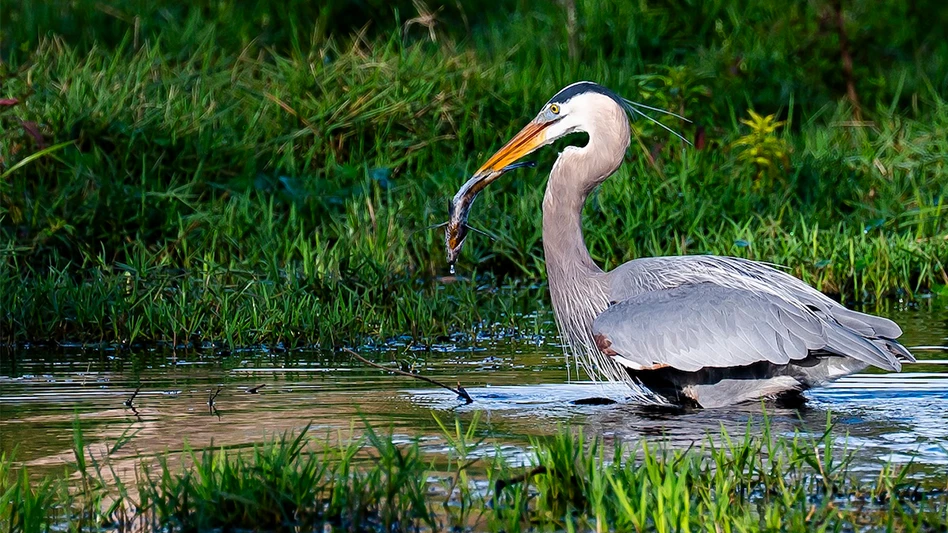We need those steenkin’ badgers
Even a moody beast like the badger has a welcome home – thanks to their preferred meals.
They’re cantankerous den dwellers that would rather stand their ground than run from any fight, and they’re calling the Princeton Golf Course in British Columbia their home. Badgers have taken up residence at the Princeton course, and superintendent Ian Elko is eager to make them feel welcome.
“About 15 years ago, we had a few badgers living on the golf course,” he says. “They really took control of the ground squirrel population. They were definitely beneficial for us. We tried a lot of things to take care of ground squirrels and rodents. Nothing worked better than the badgers out here.”
Each one of the nocturnal carnivores can put away about two ground squirrels each day. But as tough as they are, badgers are listed as endangered in B.C. Their unwillingness to run from a threat combined with poor eyesight makes them a common victim on roads and highways, which is their highest cause for fatalities. “They wouldn’t be too intimidated by a truck,” says Elko.
So when three badgers were spotted on the course last June by some club members, Elko jumped into action. He phoned the Badger Sighting Hotline to reach the South Okanagan – Similkameen (SOS) Stewardship Program with the news.
The club joined into a five-year Stewardship Agreement to help preserve the badgers and encourage them to stick around the course.
“We’re going to do our part to protect them,” he says. “We’ve put up signs around their dens for golfers to stay away, we keep vehicle traffic away. We don’t mow around their dens.”
The Stewardship Program is helping with costs for the projects, and assisting them in dealing with other native plants like toad flax and mustard weed that will help the badgers thrive at the course.
The effort is paying off as rodents keep disappearing from the course, and the partnership has alerted Elko and his staff to keep an eye out for other endangered animals that might make Princeton home. “We’re on the lookout for other species too, like the red-headed woodpecker,” he says. “The golfers like this too. We want to be stewards of our environment.”
Supers on ice
Most superintendents spend all winter trying to avoid mixing ice and green, but in Vancouver, members of the Vancouver Island Golf Superintendents Association were out on the rink to raise money to fight Multiple Sclerosis.
Members swapped their clubs for sticks and raised $100,000 for the MS Society of Canada at the 4th annual Charity Hockey Game and Banquet Jan. 29.
About four years ago, members of the association wanted to try to give back to the community, says Greg Kowalski, president of VIGSA and superintendent at Royal Oak Golf Club.
“Every Friday during the winter months, a group of us get together and play pick up hockey at one of the local rinks,” he says. “We thought the hockey game would be a perfect venue to raise funds. In our ‘family’ of people, we knew several that were afflicted with Multiple Sclerosis, so it was the perfect fit.”
Money came in from donations gathered by players and the public, as well as bids at raffles and auctions during the banquet at the Westin Bear Mountain Resort after the game. The association has raised more than $275,000 in total for the cause.
“The event was a great success, with our goal of $100,000 raised,” says Kowalski, repeating last year’s accomplishment of the same goal.
Maybe next year, we’ll see if golfers can pull a hat trick?
Roll call
J. Rhett Evans has been named the new chief executive officer of The Golf Course Superintendents Association of America (GCSAA).
Mark Esoda, superintendent, Atlanta Country Club, was inducted into the Georgia Golf Hall of Fame.
Daniel “Danny Boy” Gonzalez was awarded the 2010 Superintendent of the Year award by the Texas Gulf Coast Superintendent Association.
The Mississaugua Golf and Country Club, Mississauga, Ontario, hired Adam Zubek as its new superintendent.
Jason S. Adams, Blue Hill Country Club, was elected president of the Golf Course Superintendents Association of New England for the 2011 season.
The Iowa Golf Association announced the election of longtime superintendent and Iowa Turf Industry activist Doug Snook into its Iowa Golf Hall of Fame.
The Golf Course Superintendents Association of Northern California (GCSANC) recognized Thomas Bastis, CGCS, California Golf Club, as Superintendent of the Year; Richard Lavine, CGCS, received the George Santana Distinguished Service Award; Ryan Zuehlsdorf, The Golf Club at Roddy Ranch, and Jeff Markow, CGCS, of Cypress Point Club received Turfgrass Excellence Awards; and Terry Stratton, Little River Inn Golf & Tennis Resort received the Presidents Award.
Todd Barker, part owner and superintendent of Fore Lakes Golf Course, was inducted into the Utah Golf Hall of Fame.
Chris Condon, superintendent, Tetherow Resort and Golf Course in Bend, Ore., won a 2010 GCSAA/Golf Digest Environmental Leaders in Golf Award in the resort facilities category.
The Ford Plantation, Richmond Hill, Ga., announced the hiring of Alan Bussey, equipment manager; Brooks Riddle, assistant superintendent and Matt Sumpter, assistant in training.
Super shot
It’s very common for Sean Kjemhus to see elk moving and feeding on the Stewart Creek Golf & Country Club high-mountain course throughout the winter in Canmore, Alberta, Canada.
However, Sean shares with GCI this particularly picturesque pic he shot recently with his Blackberry.
“Here we have several elk that have worked through the snow to the turf to feed,” says the director of agronomy. “There was actually a herd of 80 elk spread out along No. 2 fairway -- which is in the picture -- No. 3 and No. 4 fairways, in trees and out in the open. They also will bed down in the open areas… that is they will clear snow away to lay down on the turf as it is much warmer than the outside temperatures. These spots that the elk feed or lay down on reveal themselves in spring time as discolorations due to the exposure to cold temperatures. In addition the elk urine through the snow creates dead patches of turf that need to be repaired in the spring”
Yet another reason Sean says they use protective fencing around all the greens in the off-season.
Check out Sean’s maintenance blog at http://stewartcreekgolf.blogspot.com.

Explore the February 2011 Issue
Check out more from this issue and find your next story to read.
Latest from Golf Course Industry
- Smart Greens Episode 1: Welcome to the digital agronomy era
- PBI-Gordon promotes Jeff Marvin
- USGA investing $1 million into Western Pennsylvania public golf
- KemperSports taps new strategy EVP
- Audubon International marks Earth Day in growth mode
- Editor’s notebook: Do your part
- Greens with Envy 66: A Southern spring road trip
- GCSAA’s Rounds 4 Research auction begins





